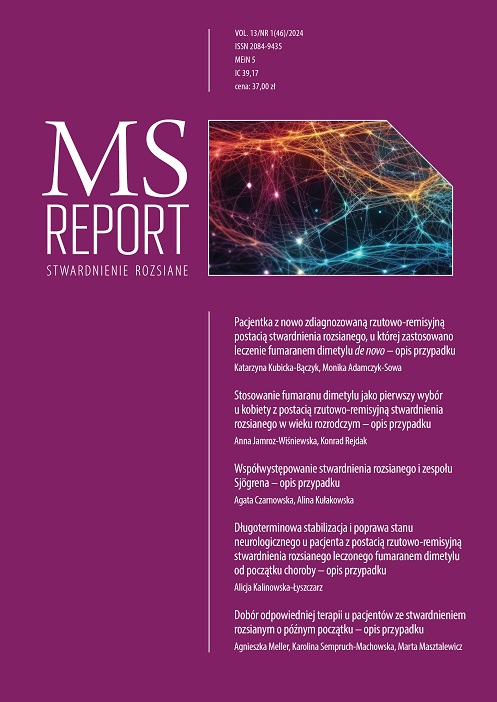Dobór odpowiedniej terapii u pacjentów ze stwardnieniem rozsianym o późnym początku – opis przypadku Opis przypadku
##plugins.themes.bootstrap3.article.main##
Abstrakt
Stwardnienie rozsiane to przewlekła choroba układu nerwowego, mogąca prowadzić do niepełnosprawności. Rozwój terapii modyfikujących przebieg choroby znacznie poprawił wyniki leczenia i długość życia pacjentów ze stwardnieniem rozsianym. Uważa się, że stwardnienie rozsiane jest chorobą ludzi młodych, gdyż najwięcej zachorowań występuje w wieku 20–40 lat, jednak należy pamiętać, iż schorzenie może dotyczyć także osób starszych. Stanowi wówczas spore wyzwanie terapeutyczne ze względu na konieczność zapewnienia bezpieczeństwa i skuteczności terapii modyfikujących przebieg choroby w specjalnej populacji chorych.
##plugins.themes.bootstrap3.article.details##
Numer
Dział
Artykuły
Copyright © by Medical Education. All rights reserved.
Bibliografia
1. Vaughn CB, Jakimovski D, Kavak KS et al. Epidemiology and treatment of multiple sclerosis in elderly populations. Nat Rev Neurol. 2019; 15(6): 329-42.
2. Hooge JP, Redekop WK. Multiple sclerosis with very late onset. Neurology. 1992; 42(10): 1907-10.
3. Grebenciucova E, Berger JR. Immunosenescence: the Role of Aging in the Predisposition to Neuro-Infectious Complications Arising from the Treatment of Multiple Sclerosis. Curr Neurol Neurosci Rep. 2017; 17: 61.
4. Shirani A, Zhao Y, Petkau J et al. Multiple sclerosis in older adults: the clinical profile and impact of interferon beta treatment. Biomed Res Int. 2015; 2015: 451912.
5. Salter A, Lancia S, Cutter G et al. Characterizing Long-term Disability Progression and Employment in NARCOMS Registry Participants with Multiple Sclerosis Taking Dimethyl Fumarate. Clin Ther. 2018; 40(12): 2077-87.
6. Frischer JM, Weigand SD, Guo Y et al. Clinical and pathological insights into the dynamic nature of the white matter multiple sclerosis plaque. Ann Neurol. 2015; 78(5): 710-21.
2. Hooge JP, Redekop WK. Multiple sclerosis with very late onset. Neurology. 1992; 42(10): 1907-10.
3. Grebenciucova E, Berger JR. Immunosenescence: the Role of Aging in the Predisposition to Neuro-Infectious Complications Arising from the Treatment of Multiple Sclerosis. Curr Neurol Neurosci Rep. 2017; 17: 61.
4. Shirani A, Zhao Y, Petkau J et al. Multiple sclerosis in older adults: the clinical profile and impact of interferon beta treatment. Biomed Res Int. 2015; 2015: 451912.
5. Salter A, Lancia S, Cutter G et al. Characterizing Long-term Disability Progression and Employment in NARCOMS Registry Participants with Multiple Sclerosis Taking Dimethyl Fumarate. Clin Ther. 2018; 40(12): 2077-87.
6. Frischer JM, Weigand SD, Guo Y et al. Clinical and pathological insights into the dynamic nature of the white matter multiple sclerosis plaque. Ann Neurol. 2015; 78(5): 710-21.

